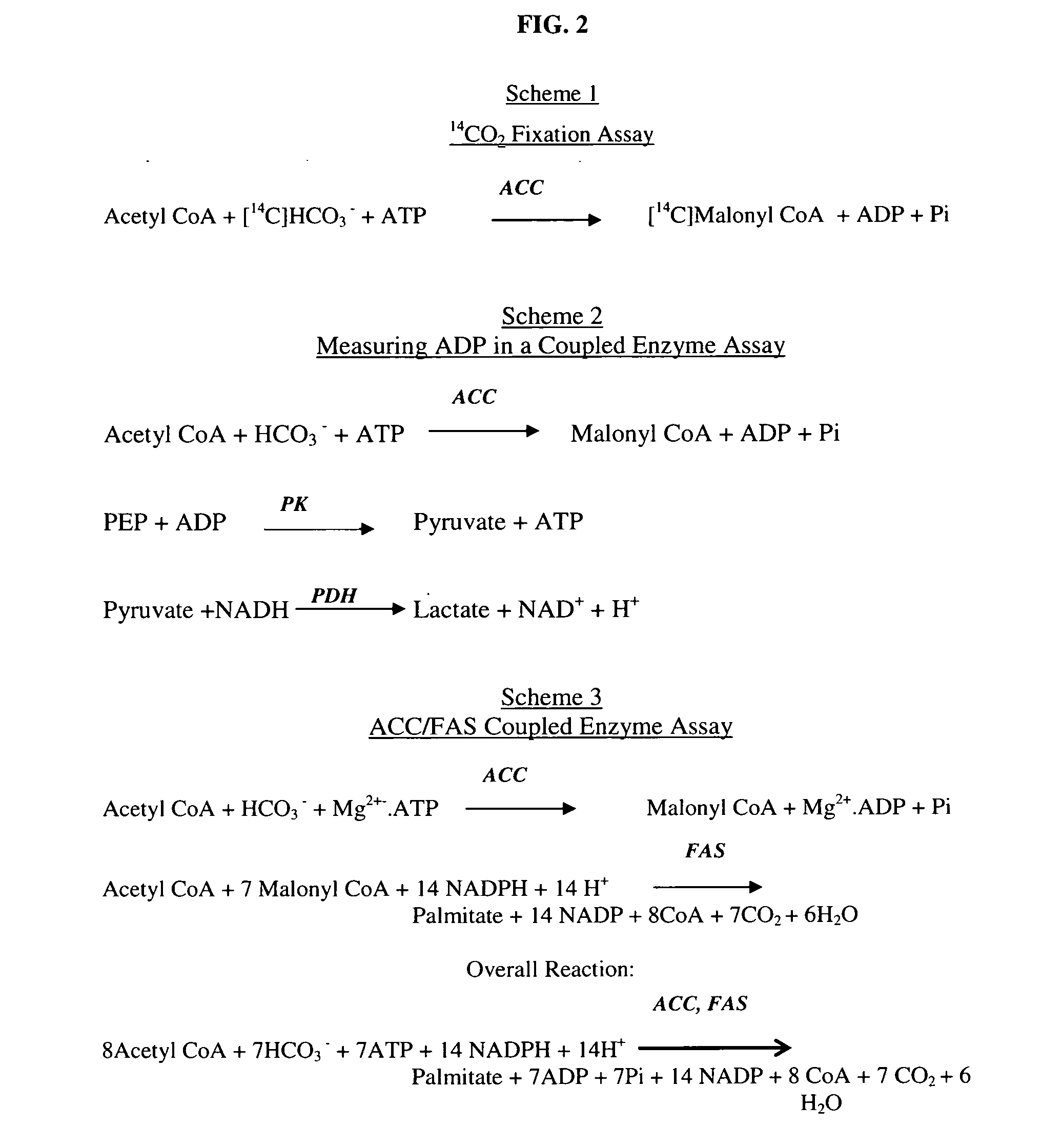Scintillation proximity assay method of measuring acetyl CoA carboxylase enzyme activity
a technology proximity assay, which is applied in the field of proximity assay of acetyl coa carboxylase enzyme activity, can solve the problems of affecting the progress of the field, lack of convenient, robust, economical enzyme assay, time-consuming and laborious, etc., and achieves the effect of maximal activity, no further increase in catalytic rate, and increased activity
- Summary
- Abstract
- Description
- Claims
- Application Information
AI Technical Summary
Benefits of technology
Problems solved by technology
Method used
Image
Examples
example 1
Enzyme Preparation
[0078] ACC and FAS were purified by a rapid purification procedure (FIG. 4) from frozen livers of rats that were fasted for 36 hours and fed with fat-free carbohydrate diet for 48 hours (Seethala & Benjamin, (1983) Preparative Biochem. 13:475-488; Jamil & Madsen, (1987) J. Biol. Chem. 262:630-637). The livers were thawed and washed with PBS buffer and minced into small pieces in 3 volumes of buffer A (50 mM potassium phosphate buffer, pH 7.5, 1 mM EDTA, 0.1 mM EGTA, 10 mM β mercaptoethanol, 5 mM benzamidine, protease inhibitor cocktail (10 μM TLCK, 1 μg / ml of leupeptin, aprotinin, pepstatin, AEBSF, pepstatin A and trypsin inhibitor) and 250 mM sucrose) and homogenized in Polytron 4×1 min. All the operations were done at 4° C. or on ice. The homogenate was centrifuged at 5000×g for 5 min. The supernatant 1 was saved and the pellet suspended in one volume of buffer A and rehomogenized in Polytron 4×1 min and centrifuged at 5000×g for 5 min. The pellet was discarded ...
example 2
Solution Preparation and Assay Conditions
[0080] Assay Buffer: 50 mM Tris-HCl, pH 7.6, 10 mM Na Citrate, 4 mM ATP, 10 mM MgCl2, 6 mM NaHCO3, 1 mM EDTA, 100 μM NADPH.
[0081] 5×[3H]-Acetyl CoA mix: To [3H]-Acetyl CoA, unlabeled acetyl CoA was added to a total concentration of 100 μM in the assay buffer. The [3H]-acetyl CoA mix in the final reaction was 20 μM with 0.25 μCi per assay (specific activity of 250 μCi / μmol).
[0082] Enzyme mix: To each well, 0.1 μg of rat acetyl CoA carboxylase 1 (rACC) and 2 μg of rat fatty acid synthase (rFAS) in a total volume of 35 μl in the assay buffer was added.
[0083] Compound Dilution: Compounds were dissolved in 100% DMSO to obtain 10 mM stock solution. A serial dilution of the compounds in 100% DMSO was made first. Then the compounds were diluted 1:33.3 in buffer to obtain 10× compound solution in 3% DMSO. From this intermediate dilution, a further 10× dilution was made in the assay, resulting 0.3% final DMSO concentration in the assay.
[0084] The ...
example 3
Reaction Time Course
[0091] In a representative optimization of the ACC / FAS-coupled SPA assay, MgCl2, ATP, NaHCO3, sodium citrate, acetyl CoA, and NADPH were added to assay buffer and the reaction was initiated with the addition of ACC and FAS. For determining the compound inhibition, MgCl2, ATP, NaHCO3, sodium citrate, ACC, FAS, and NADPH were added to the assay buffer and the reaction was started by the addition of [3H]-acetyl CoA mix.
[0092] The time course of reaction was studied at room temperature (RT, 21° C.) and at 37° C. The reaction was linear up to 5 hours at both temperatures (FIG. 5). However, the maximum signal to background (S / B) was higher at 37° C. than at RT (S / B=12 at RT and S / B=32 at 37° C.). The preferred incubation condition was 37° C. for 2 hours. There was minimal signal change when the plates were kept at 4° C. after incubation at 37° C. (Table 1). Thus, the reaction can be quenched by chilling the plate at 4° C. When a large number of plates are processed a...
PUM
| Property | Measurement | Unit |
|---|---|---|
| wave length | aaaaa | aaaaa |
| temperature | aaaaa | aaaaa |
| pH | aaaaa | aaaaa |
Abstract
Description
Claims
Application Information
 Login to View More
Login to View More - R&D
- Intellectual Property
- Life Sciences
- Materials
- Tech Scout
- Unparalleled Data Quality
- Higher Quality Content
- 60% Fewer Hallucinations
Browse by: Latest US Patents, China's latest patents, Technical Efficacy Thesaurus, Application Domain, Technology Topic, Popular Technical Reports.
© 2025 PatSnap. All rights reserved.Legal|Privacy policy|Modern Slavery Act Transparency Statement|Sitemap|About US| Contact US: help@patsnap.com



